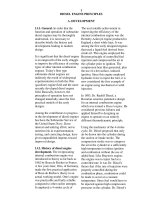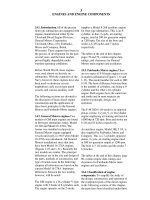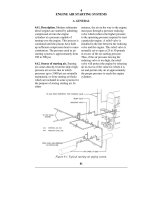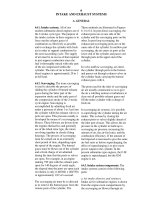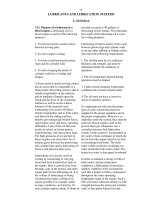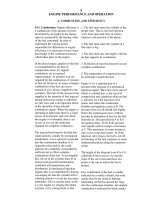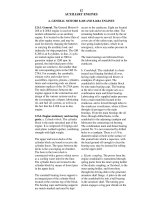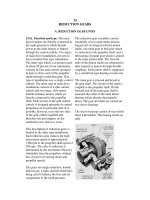Tài liệu Diezel 1410 P3
Bạn đang xem bản rút gọn của tài liệu. Xem và tải ngay bản đầy đủ của tài liệu tại đây (1.74 MB, 48 trang )
3
ENGINES AND ENGINE COMPONENTS
3A1. Introduction.All of the present
fleet type submarines are equipped with
engines manufactured either by the
Cleveland Diesel Engine Division,
General Motors Corporation,
Cleveland, Ohio, or by Fairbanks,
Morse and Company, Beloit,
Wisconsin. These engines have been in
the process of development for the past
several years, and the latest models
proved highly dependable under
wartime operating conditions.
Before World War II, these engines
were used almost exclusively on
submarines. With the expansion of the
Navy, however, these engines have also
been used on destroyer escorts,
amphibious craft, escort type patrol
vessels, and various auxiliary craft.
The following sections are devoted to
the discussion of basic diesel engine
construction and the application of
these basic principles to the General
Motors and Fairbanks-Morse engines.
3A2. General Motors engines.Two
models of GM main engines are found
in fleet type submarines today, Model
16-248 and Model 16-278A. The
former was installed exclusively in
General Motors engine equipped
vessels until early in 1943 when Model
16-278A was introduced. All General
Motors installations since that time
have been Model 16-278A engines
(Figures 1-10 and 1-11). Basically the
two models are similar. The principal
differences are in the size and design of
the parts, methods of construction, and
type of metals used. In the following
chapters all references are based on the
current Model 16-278A. Important
differences between the two models,
however, will be noted.
The GM engine is a 16-cylinder V-type
engine with 2 banks of 8 cylinders each
The engine operates on the 2-stroke
supplies a Model 8-268 auxiliary engine
for fleet type submarines. This is an 8-
cylinder, in-line, 2-cycle, air starting
engine, rated at 300 kw generator output
at 1200 rpm. The size of the bore and
stroke is 6 3/8 inches and 7 inches
respectively.
The tables at the end of this chapter,
pages 78 and 79, contain engine data,
ratings, and clearances for General
Motors main engines and auxiliaries.
3A3. Fairbanks-Morse engines.There
are two types of F-M main engines in use
in modern submarines (Figures 1-12 and
1-13). The model number for each is 38D
8 1/8. The basic difference between them
is the number of cylinders, one being a 9-
cylinder and the other a 10-cylinder
engine. Both engines have the same bore
and stroke and in most respects are
similar in principle, design, and
operation.
The F-M 38D 8 1/8 model is an opposed
piston, in-line, 2-cycle, 9- or 10-cylinder
engine employing air starting and rated at
1600 bhp at 720 rpm. Bore and stroke are
8 1/8 and 10 inches respectively.
An auxiliary engine, Model 38E 5 1/4, is
also supplied by Fairbanks, Morse and
Company. This is a 7-cylinder, opposed
piston, 2 cycle, air starting engine rated
at 300 kw generator output at 1200 rpm.
The bore is 5 1/4 inches and the stroke 7
1/4 inches.
The tables at the end of this chapter, page
80, contain engine data, ratings and
clearances for Fairbanks-Morse main
engines and auxiliaries.
3A4. Classification of engine
components. To simplify the study of
the design, construction, and operation of
the component parts of the diesel engines
in the following sections of this chapter,
the parts have been classified under three
cycle principle, is air started, and is
rated at 1600 bhp at 750 rpm. The size
of the bore and stroke of the 16-248
engine is 8 1/2 inches and 10 1/2 inches
respectively as compared to 8 3/4
inches and 10 1/2 inches for Model 16-
278A.
The General Motors Corporation also
subjects as follows: 1) main stationary
parts, 2) main moving parts, and 3)
valves and valve actuating gear.
Section 3B deals with engine
components as listed above, in general.
Sections 3C and 3D deal with the same
components as applied to the GM and F-
M engines respectively. In all
34
instances the ends of the engines will
be referred to as the blower and the
control ends. It should be noted that the
blower end of the
F-M engines is also the generator
coupling end, whereas the blower end of
the GM engines is opposite the generator
coupling end.
B. GENERAL DESCRIPTION OF ENGINE COMPONENTS
3B1. Main stationary parts.a. Frame.
The framework of the diesel engine is
the load carrying part of the machinery.
The design of diesel engine frames has
undergone numerous changes in recent
years. Some of the earlier types of
framework which were eventually
abandoned were: 1) A-frame type, 2)
crankcase type, 3) trestle type, 4) stay-
bolt or tie rod type.
The framework used in most modern
engines is usually a combination of
these types and is commonly
designated as a welded steel frame. A
frame of this type possesses the
advantages of combining greatest
possible strength, lightest possible
weight, and greatest stress resisting
qualities.
The welded steel type of construction is
made possible by the use of recent
developments in superior quality steel.
For diesel engine frame construction,
steel is generally used in thick rolled
plates which have good welding
quality. In this type of construction,
deckplates are generally fashioned to
house and hold the cylinders, and the
uprights and other members are
welded, with the deckplates, into one
rigid unit.
b. Oil drain pan. The oil drain pan is
attached to the bottom of the cylinder
other parts for inspection and repair. The
doors are usually secured with
handwheel or nut operated clamps and
are fitted with gaskets to keep dirt and
foreign material out of the interior. Some
of these access doors or inspection covers
may be constructed to serve as safety
covers. A safety cover is equipped with a
spring-loaded pressure plate. The spring
maintains a pressure which keeps the
cover sealed under normal operating
conditions. An explosion or extreme
pressure within the crankcase overcomes
the spring tension and the safety cover
acts as an escape vent, thus reducing
crankcase pressure.
d. Cylinder and cylinder liners. The
cylinder is the enclosed space in which
the mixture of air and fuel is burned. A
cylinder may be constructed of a varying
number of parts among which the
essentials are the cylinder jacket, the
cylinder liner, and in most cases the
cylinder head. In most designs the space
between the cylinder jacket and the liner
is cored to carry circulating water for
cooling purposes.
There are two general types of cylinder
liners. One, the wet type, is a replaceable
liner that makes direct contact with the
cooling water; the other, the dry type, is a
replaceable liner that fits into a water-
cooled jacket without making direct
contact with cooling water. All
block and serves to collect and drain oil
from the lubricated moving parts of the
engine. The bottom of the oil pan is
provided with a drain hole at each end
through which oil runs to the sump
tank. In some installations the bottom
of the pan slopes toward one end or the
other of the engine.
Oil drain pans require little
maintenance. They should be cleaned
and flushed of any residual dirt during
major overhaul periods. New gaskets
should be installed at these times to
assure an oiltight seal.
c. Access doors and inspection covers.
The cylinder block walls are equipped
with access doors or handhole covers.
With the doors or covers removed, the
openings furnish access to cylinder
liners, main and connecting rod
bearings, injector control shafts, and
various
submarine diesel engines under
consideration here use the wet type
cylinder liners.
e. Cylinder head. The cylinder head seals
the end of the cylinder and usually
carries the valves. Heads must be strong
enough to withstand the maximum
pressures developed in the cylinders.
Also, the joint between the cylinder and
the head must be gastight. Due to the
high temperatures encountered, cylinder
heads must be water cooled. To
accomplish this, water passages are cored
in the head during the casting process.
Valves usually found in the head are the
exhaust valves, injection valves, and air
starting valves.
3B2. Main moving parts.a. General.
The main moving parts of a diesel engine
are those
35
that convert the power developed in the
cylinders by combustion to mechanical
energy, that is delivered to the shaft.
These parts are used to change the
reciprocating motion of the pistons in
the cylinders to rotary motion at the
engine final drive, and may be divided
into three major groups:
1. Those parts having rotary motion,
such as crankshafts and camshafts.
2. Those parts having reciprocating
motion, as, for example, the pistons and
piston rings.
3. Those parts having both
reciprocating and rotary motion, such
as the connecting rods.
b. Crankshaft. The crankshaft
transforms the reciprocating motion of
the pistons into rotary motion of the
output shaft. It is one of the largest and
most important moving parts of a diesel
engine.
The materials used in the construction
Figure 3-1. Nomenclature of crankshaft
parts.
of crankshafts vary greatly, depending
on the size of the shaft, speed of the
engine, horsepower of engine, and
number of main bearings. Regardless o
f
materials used, crankshafts are always
heat treated. This is necessary in order
to give uniform grain structure, which
increases ductility and capacity for
resisting shock. The tensile strength of
crankshaft materials varies from 60,000
psi to as much as 100,000 psi.
Crankshafts may be either forged or
cast. They may be either made up in
one section, or in two or more with the
sections interchangeable for economy
in construction and replacement.
Crankshafts are machined to very close
limits with a high finish and are
balanced both statically and
dynamically.
The crankshaft consists essentially of a
number of cranks placed at equal
angular intervals around the axis of the
shaft. Between the cranks are the
crankshaft supports commonly referred
to as the journals. Each crank on a
crankshaft is made up of the crankpin,
which is the journal for the connecting
rod bearing, and two crank webs
(Figure 3-1).
Journals, crankpins, and webs are
drilled for the passage of lubricating oil
(Figure 3-2). All such holes are usually
straight to facilitate construction and
cleaning of the passages. In larger
engines, crankshafts are practically
always constructed with hollow main
bearing journals and crankpins. This
construction is
Figure 3-2. Sections of crankshaft
showing oil passages and hollow
construction.
36
much lighter than a solid shaft and is
better adapted for carrying the
lubricating oil to various bearings in the
engine. In large engines, the crankshaft
is sometimes built up by pressing the
journals into the webs. In this type,
generally, the crankpin and its two
adjacent webs are forged or cast in one
piece, this unit then being joined to
other cranks by hydraulically pressing
them onto the main bearing journals.
lubricant to prevent a metal-to-metal
contact between the journal and bearing
surfaces. Excessive clearance permits the
free flow of the fluid oil to the edges of
the bearing. This reduces the pressure
developed and consequently may
overload the bearing. The stress of
overload will cause the bearing to wipe
and eventually burn out. Both bearing
clearances and the amount of wear may
be checked by measuring the thickness of
The cranks are held at the proper angles
during this process, after which the
assembled shaft is put in a lathe and
finished to size.
c. Main bearings. The function of the
main bearings is to provide supports in
which the crankshaft main bearing
journals may revolve. In the diesel
engines under discussion, modern
bimetal or trimetal, split sleeve,
precision type main bearings are used
exclusively. Bimetal bearings consist o
f
a thin inner layer of soft low-friction
metal encased in a shell of harder metal
fitted to the bearing support or bearing
cap. Trimetal bearings have an
intermediate layer of bronze between
the shell and soft metal layers. Both
types are split sleeve, divided
horizontally through the center, for
installation. Precision type manufacture
requires that the bearing housing be
precision bored to a close tolerance and
that the bearing halves, when tightly
drawn together, align perfectly and fit
the bearing journals with a
predetermined clearance. The purpose
of this clearance is to provide for a thin
film of lubricating oil which is forced
under pressure between the journals
and bearing surfaces. Under proper
operating conditions this oil film
entirely surrounds the journals at all
engine load pressures.
All main bearings contain oil inlet
holes and oil grooves which permit the
oil to enter and be evenly distributed
throughout the inside of the bearing.
These oil inlets and grooves are
invariably in the low oil pressure area
of the bearing.
Proper bearing lubrication depends
upon accurate bearing clearances as
well as the type of lubrication. Too
little clearance will cause the bearing to
run hot and wipe out under continued
operation. At high operating speeds
with too little clearance, the load
pressure on the bearing does not leave
sufficient room for the
the soft metal lining of the bearing shell
either with a ball point micrometer or by
the use of appropriate feeler gages.
Proper seating of the bearing shells and
proper clearances of precision type
bearing shells require that the bearing
caps be drawn to the proper tightness.
This is done with a torque wrench by
means of which the proper torque limits
in foot-pounds are obtained. As this
torque varies with engine models, the
current instructions should be consulted.
d. Pistons. The function of a piston is to
form a freely movable, gastight closure
in
Figure 3-3. Main bearing shells.
37
the cylinder for the combustion
chamber. When combustion occurs, the
piston transmits the reciprocal motion
or power created to the connecting rod.
Pistons for all the modern submarine 2-
stroke cycle diesel engines are of the
trunk type. Pistons of the trunk type
have sufficient length to give adequate
bearing surface against the side thrust
of the connecting rod. Trunk type
pistons have a slight amount of taper at
the crown end of the piston to provide
for the greater expansion of the metal at
the combustion end where temperatures
as high as 3000 degrees F may be
encountered. This taper is sufficient so
that at normal operating temperatures
the piston assumes the same diameter
throughout its entire length.
The piston crowns on both the GM and
F-M engines are concave. The purpose
of this shape is to assist in air
turbulence which mixes fuel with air
during the last phase of the
compression stroke.
Pistons are usually constructed of either
a cast iron or aluminum alloy. They
must be designed to withstand the gas
pressure developed in the combustion
chamber during the compression and
expansion strokes. They must also be
light enough to keep the inertia loads
on the piston pins and main cranks to a
minimum.
e. Piston rings. Piston rings have the
following three primary functions:
1. To seal compression in the
combustion chamber.
2. To transfer heat from the piston to
the cylinder wall.
3. To distribute and control lubricating
oil on the cylinder wall.
In general, piston rings are of two
types. One, the compression type ring,
serves primarily to seal the cylinder
against compression loss; the other, the
oil type ring, distributes oil on the
and the integral hub of the connecting
rod. The piston pin must be strong
enough to transmit power developed by
the piston to the crankshaft through the
connecting rod. Piston pins are usually
hollow and are made of special alloy
steels, case hardened and ground to size.
The connection between the piston and
the piston pin is either by means of
needle type roller bearings or by plain
bushings. The ends of the pins must not
protrude beyond the surface of the piston,
and their edges must be rounded to
facilitate entry of the piston into the
cylinder. This is usually accomplished by
means of piston pin caps.
g. Connecting rods. Just as its name
implies, the connecting rod connects the
piston with the crankshaft. It performs
the work of converting the reciprocating,
or back-and-forth, motion of the piston
into the rotary, or circular, motion of the
crankshaft. The usual type of connecting
rod is an I-beam alloy steel forging, one
end of which has a closed hub and the
other end an integral bolted cap. The cap
is accurately located by means of dowel
pins. Through the closed hub, the
connection is made between the piston
and the connecting rod by means of the
piston pin. At the other end, the
connecting rod bearing connection is
made between the connecting rod and the
crankshaft. The shaft of the connecting
rod is drilled from the connecting rod
bearing seat to the piston pin bushing
seat. Through this passage, lubricating oil
is forced from the connecting rod bearing
to the piston pin bearing for lubrication
and piston cooling.
h. Connecting rod bearings. The purpose
of these bearings is to form a low-
friction, well-lubricated surface between
the connecting rod and the crankshaft in
which the crankpin journals can revolve
freely. The bearings used are generally o
f
the same material and type as the main
bearings. Connecting rod bearings
consist of two halves or bearing shells.
The backs of these shells are bronze or
steel, accurately machined to fit into a
precision machined bearing seat in the
cylinder walls and controls cylinder
wall lubrication by collecting and
draining excess oil.
Piston rings are generally constructed
of cast iron. On the average diesel
piston there are four to five
compression rings and two or three oil
control rings.
f. Piston pins. Each piston is connected
to the connecting rod by a piston pin or
wrist pin. This connection is through
bored holes in the piston pin hubs at the
center of the piston
connecting rod. The shells are lined with
a layer of soft metal of uniform
thickness. When the bearing caps are
drawn tight on the connecting rod, the
contact faces of the bearing shells form
an oiltight joint. Also, because of the
precision manufacture of all parts,
38
the bearing shells give the proper
clearance between the bearing shells
and the crankpin journals. The
connecting rod bearings are pressure
lubricated by oil forced through oil
passages from the main bearings to the
crankpin journals. The oil is evenly
distributed over the bearing surfaces by
oil grooves in the shells.
Figure 3-4. Connecting rod bearing
shells.
3B3. Valves and valve actuating
gear.a. General. Control of the flow of
fuel, inlet air, starting air, and exhaust
gases in a diesel cylinder is
accomplished by means of various
types of valves. The timing and
operation of these valves, for the
various processes in relation to piston
travel and correct firing sequence, are
the main functions of the valve
actuating gear.
Since certain phases of timing, such as
the geometrical angle of the crankshaft
with the operation of the crankshaft
through the camshaft drive. In addition to
actuating valves, camshafts, on some
engines, are also used for driving
auxiliaries such as governors and
tachometers.
Camshafts are usually constructed in one
or two parts. The number of cams on a
camshaft is determined by the type and
cycle of engine. The cams and camshafts
are usually forged integral and ground to
a master camshaft.
c. Valves. The important valves found on
typical diesel cylinders and their
functions are:
1. Exhaust valves. Exhaust valves are
used to allow the exhaust gases of
combustion to escape from the cylinders.
They are subject to extremely high
temperatures and are therefore made of
special heat-resistant alloys. In some
large engines, the exhaust valves are
water cooled.
2. Inlet valves. Inlet valves are used to
govern the entrance of air in the cylinder
of a 4-stroke cycle engine. Inlet valves
are not used
cranks and the geometrical angle of the
camshaft cams, are fixed, timing
adjustments are made through the valve
actuating gear. Hence, timing
adjustments must be made with
extreme accuracy and the valve
actuating gear must function perfectly
for efficient engine operation.
b. Camshafts. The purpose of the
camshafts in submarine diesel engines
is to actuate exhaust valves, fuel
injectors, fuel injection pumps, and air
starting valves according to the proper
timing sequence of that particular
engine.
In order to perform these functions at
the various cylinders in relation to their
proper firing order, the camshafts are
timed or synchronized
Figure 3-5. Valve actuating gear
assembly.
39
in modern submarine diesel engines,
having been replaced by inlet ports.
3. Fuel injection valves. Fuel injection
valves are used to inject the fuel spray
into the cylinder at the proper time with
the correct degree of atomization. In
addition, some injection valves also
measure the amount of fuel injected.
4. Air starting valves. Air starting
valves are used to control the flow of
starting air during air starting of an
engine. These valves are normally of
two types, air starting check valves and
air starting distributor valves.
5. Cylinder test valves. Each cylinder is
provided with a test valve which is used
to vent the cylinder before starting.
This valve is also used to relieve the
cylinder of compression when turning
over the engine by hand. The same
valve is used far taking compression
and firing
pressure readings of the cylinder while
the engine is in operation.
6. Cylinder relief valves. A cylinder
relief, or safety, valve is located on each
cylinder of all submarine type engines.
The function of this valve is to open and
relieve the cylinder when pressure inside
the cylinder becomes excessive. These
valves are adjustable to be set at varying
pressures according to the particular
installation. When pressure drops below
the setting at which the valve opens, the
valve closes automatically.
d. Valve actuating gear. Motion of the
cams on the camshaft is transmitted to
valves, injectors, and injector pumps by
means of rocker arms or tappet
assemblies. The rocker arms and tappets
normally are spring loaded and make
contact with the cams by means of cam
rollers. Adjustments of the various
springs and rods are very important, as
they are normally the means by which
the engine is correctly timed.
C. GENERAL MOTORS ENGINE COMPONENTS
3C1. General.Descriptions of engine
components in this section apply only
openings in the sides of the cylinder
block. Access to the injector control shaft
to the General Motors engine.
3C2. Main stationary parts.a.
Cylinder block. The cylinder block of
the GM engine (Figure 3-8) is
fabricated from forgings and steel
plates welded together to form a single
unit. The assembly is designed with
two cylinder banks, the axes of which
are 40 degrees apart, forming the V-
type design of the engine. The unit is
fabricated from main structural pieces
called transverse frame members, upper
and lower deckplates for each bank,
and cross braces all welded into one
rigid compact unit. The upper and
lower deckplates are bored to
accommodate the cylinder liners. The
space between these deckplates, as well
as the space between the two banks of
cylinders, serves as a scavenging air
chamber.
The forged transverse members in the
bottom of the cylinder block form the
mounting pads for the lower main
bearing seats. The camshaft bearing
lower seats are an integral part of the
cylinder block. These bearing seats and
their caps are match-marked and must
be kept together.
Removable handhole covers close the
is obtained by removing the top row of
small handhole covers. The middle row
of handhole covers permits access to the
scavenging air box for inspection of the
cylinder liners and piston rings. The
bottom row of handhole covers permits
access to the crankshaft, connecting rod,
and bearings.
b. Engine oil pan. The engine oil pan is
bolted to the bottom of the cylinder
block. The bottom of the oil pan is
provided with a drain hole at each end.
One end of the oil pan is fastened to the
camshaft gear train housing and the other
end is fastened to the blower bottom
housing. The lubricating oil from these
units drains into the oil pan. The pan is
constructed of welded steel in the 16-
278A and of an aluminum alloy casting
in the 16-248.
c. Cylinder liner. The cylinder liner
(Figure 3-11) is made of cast iron with a
cored or hollow space in the wall through
which cooling water is circulated. Water
enters through a synthetic rubber gasket
sealed connection near the bottom of the
cylinder and circulates out through
similarly sealed steel ferrules into the
cylinder head. The cylinder liner is held
in the engine block by the lower
deckplate and a
40
Figure 3-6. LONGITUDINAL CUTAWAY OF GM 16-278A ENGINE.
Figure 3-7. Cross section of GM 16-278A engine.
41
Figure 3-8. Section of cylinder block, GM.
Figure 3-9. Crankcase handhole
covers, GM.
Figure 3-10. Injector control shaft and
air box handhole covers, GM.
42
recess in the upper deckplate, and is
held securely to the cylinder head by
six steel studs and nuts The joint
between the liner and the lower deck
plate is made up with an oil-resistant
seal ring made of neoprene which is
compressed in a groove in the
deckplate bore. This makes a tight joint
and prevents the leakage of scavenging
air from the air chamber and the
leakage of oil from the crankcase into
the air chamber. A solid copper gasket,
slightly recessed in a groove of the
cylinder liner, seats against the cylinder
head to form a pressure seal.
Scavenging air intake ports are located
near the center of the liner. They also
serve as piston and ring inspection
ports.
The distance from the upper ends of the
scavenging air ports to the finished top
of the cylinder liner must be closely
held to the required dimension, so that
the opening and closing of these ports
by the travel of the piston are
accurately timed in relation to the
respective opening and closing of the
exhaust valves.
In recent years it has been found that
the wearing qualities of the liner can be
greatly increased by chrome plating the
inside of the liner. These chrome-plated
liners are used in all late installations.
Figure 3-11. Cross section of cylinder
liner, GM.
cylinder head is sealed against
compression loss by a solid copper
gasket which is slightly recessed in a
groove of the cylinder liner. All other
joints or openings of the cylinder head
are made watertight or oiltight by
gaskets.
3C3. Main moving parts.a. Crankshaft.
The GM crankshaft (Figure 3-15) is an
integral type, alloy steel forging, heat
treated for stress and wear resistance, and
dynamically and statically balanced.
Shaft and crankpins are hollow bored to
reduce weight and bearing load. The
entire crankshaft is machine finished, and
the main bearing and crankpin journals
d. Cylinder head. The cylinder head
attaches to the cylinder liner to form the
top closure of the combustion chamber.
It forms the support and houses the four
exhaust valves, the unit injector, and
the rocker lever assemblies. It also
contains the overspeed injector lock, air
starter check valve, cylinder relief
valve, and cylinder test valve (Figure 3-
12).
The cylinder head is an individual unit
for each cylinder. It consists of an alloy
iron casting, cored with water cooling
passages. Cooling water flows from the
cylinder liner through synthetic rubber
sealed steel ferrules, and circulates
through the cylinder head. It then
passes through a watertight connection
into the water jacket of the exhaust
elbow. All cylinder heads are equipped
with a pressed steel or aluminum alloy
cover secured by a handwheel nut. This
cover has breather openings which
serve as ventilating ports for the
crankcase breather system. Each
cylinder head is fastened to the cylinder
block by four hold-down studs and
nuts. The joint between the cylinder
liner and
are precision ground. Crankshafts for
right-hand and left-hand engines are
interchangeable. There are eight cranks
spaced 45 degrees apart and nine main
bearing journals on each crankshaft. In
both right-hand and left-hand engines,
the cylinders are numbered from 1 to 8
inclusive in the right bank, and from 9 to
16 inclusive in the left bank. Cylinders 1
and 9 are at the blower end of each
engine. Two pistons that are
43
Figure 3-12. Cylinder head, GM.
44
opposite each other in the two banks
are connected to each crank by
connecting rods. Each crank or
crankpin is referred to by the numbers
of the two cylinders to which it is
related.
The firing interval is alternately 5
degrees and 40 degrees and these
intervals are determined by the angle
between the cylinder banks, which is 40
degrees, and by the relation of the
crankpin positions of successively fired
cylinders, which is 45 degrees. Two
successively fired cylinders are
connected either to two separate
crankpins that are 45 degrees apart, or
to one crankpin. When two
successively fired cylinders have
crankpins that are 45 degrees apart,
Figure 3-13. Cylinder head cross section
through exhaust valves, GM.
which is 5 degrees greater than the
bank angle of 40 degrees, the firing
interval is 5 degrees. When two
successively fired cylinders are
connected to one crankpin, the firing
interval is the same as the bank angle,
which is 40 degrees.
Oil passages are drilled through each
crankpin, crank webs, and main bearing
journals, for lubricating oil to flow
under pressure from the main bearings
to the connecting rod bearings. The
connection between the crankshaft and
the main generator is by means of an
elastic coupling.
b. Main bearings. The crankcase
contains nine bearings (Figures 3-16
and 3-17) for the support of the
crankshaft. Each main bearing consists
of an upper and lower double flanged
precision bearing shell. Two types of
main bearing shells are used. One type
is bronze backed with a centrifugally
cast lining of high lead bearing metal
known as Satco metal. The other type is
steel backed with an intermediate lining
of bronze and lined with Satco metal.
The bearings are carried in a steel
bearing support and held by a steel
bearing cap. Both bearing supports and
bearing caps are made of drop-forged,
heat-treated steel. Each of the bearing
supports is secured to the main frame o
f
the crankcase. Two large dowel pins
locate the supports for perfect
alignment.
The upper bearing shell is mounted in
the bearing cap, the lower shell in the
main bearing seat. The joint faces of
the upper and lower bearing shells
project slightly from the seat and cap.
This is to insure that the backs of the
shells will be forced into full contact
when the cap is fully tightened. A
drilled hole in the upper shell
Figure 3-14. Cylinder head cross section
through injector, GM.
45
Fi
gure 3-15. Crankshaft for GM engine.
fits on a dowel pin in the cap. The
dowel pin locates the upper shell in the
bearing cap and prevents both the upper
and lower shells from rotating.
Bearing caps are held down on the
bearings by jack screws locked with
cotter pins. The jack screw fits into a
recess in the arch of the crankcase
frame and takes the upward thrust on
the bearing cap. Close fit between
shoulders on the crankcase frame
prevents side play in the bearing cap.
End play is controlled by two dowel
pins. When the bearing supports and
caps are assembled on the crankcase
frames, the seats for the bearing shells
are accurately bored in dine, and the
ends of its faces are finished for a close
fit between the bearing shell flanges.
Each bearing shell is marked on the
edge of one flange. For example, the
designation 2-L-B.E. indicates that the
shell is for the No. 2 main bearing, that
it is the lower shell, and that the flange
of the shell thus marked should be
placed toward the blower end of the
engine. The main bearing nearest the
blower end of the engine is the No. 1
main bearing. The rear main bearing
(No. 9) is the thrust bearing. Thrust
bearing shells are the same as the other
main bearing shells except that the
bearing metal is extended to cover the
flanges. With the exception of the thrust
bearing, all upper bearing shells are alike
and interchangeable before they are
assembled and marked This is also true
of the lower bearing shells. Upper and
lower shells, however, are not
interchangeable with each other.
Each lower bearing shell has an oil
groove starting at the joint face and
extending only partially toward the
center of the bearing surface. The upper
bearing shells are similarly grooved
except that the groove is complete from
joint face to joint face.
The main bearings are lubricated by oil
under pressure received from the oil
manifold under the bearing supports. The
oil is forced up through a passage in the
bearing support and through holes drilled
in the lower bearing shell. From these
holes, oil flows the entire length of the
oil groove formed by the combined upper
and lower shells. The oil lubricates the
entire bearing surface and is carried off
through the
46
drilled passages in the crankshaft to the
connecting rod bearings.
c. Pistons and piston rings. The pistons
for GM engines are made of cast iron
alloy which is tin plated. Each piston is
of small oil grooves cut lengthwise in the
bore and these receive lubricating oil that
splashes from the sprayed head and side
wall surfaces.
A cooling oil chamber is formed by an
fitted with five compression rings at the
upper, or crown, end and two oil
control rings at the bottom, or skirt,
end. In latest installations, the oil
control rings are of the split type
backed by expanders. All piston rings
are made of cast iron.
The bored holes in the piston pin hubs
are fitted with hard bronze bushings
which are cold shrunk in the piston
bores. The outer ends of the bore for
the piston pin are sealed with cast iron
caps to prevent injury to the walls of
the cylinder from floating piston pins.
The bores in the piston pin bushing are
accurately ground in line for the close,
but floating, piston pin fit. Each
bushing has a number
integral baffle under the piston crown.
Lubricating oil under pressure flows
from the top of the connecting rod,
through a sealing member, and into the
cooling chamber. The oil seal is a spring
loaded shoe which rides on the
cylindrical top of the connecting rod. The
heated oil overflows through two drain
passages.
d. Piston pins. The piston pin used on the
GM engine is full floating, hollow bored,
and case hardened on the bearing surface.
The connection between connecting rod
and the piston is by means of the
connecting rod piston pin bushing. This
bushing rotates freely inside the integral
end of the connecting rod, and the
connection is completed by pushing the
piston
Figure 3-16. Main bearing cap installed, GM.
47
Fi
gure 3-17. Main bearing shells. GM.
pin through the connecting rod piston
pin bushing and the piston pin hub
bushings.
In some older installations a needle
type bearing containing three rows of
53 small roller bearings each was used
instead of the connecting rod piston pin
bushing. These have now been replaced
by the bushing type of bearing.
The connecting rod piston pin bushing
is constructed of steel-backed bronze.
The entire length of the inner surface of
the bushing is grooved to provide for
lubrication of the piston pin assembly.
e. Connecting rods and connecting rod
bearings. GM connecting rods are
made of alloy steel forgings. The rod is
forged in an I-section with a closed hub
at the piston pin end and with an
integral cap at the lower end. The cap is
saw-cut from the rod in the machining
operation. The cap is accurately located
on the
rod by two dowel pins. On the 16-248 the
cap is fastened to the rod by four studs
and castle nuts. For greater security, the
studs are pinned in the rod. On the 16-
278A the cap is fastened to the rod by
four bolts with castle nuts. The crankpin
bearing hub of the rod is turned to a
lateral diameter which is smaller than the
cylinder bore, so that the connecting rod
will pass through the cylinder bore.
The connecting rod bearing is made up o
f
upper and lower bearing shells. There are
two types of connecting rod bearing
shells used in the Series 16-278A
engines. One type is bronze backed with
a centrifugally cast lining of Satco metal
of the same composition as that used in
the main bearings. The other type is steel
backed with an intermediate lining of
bronze and an inner lining of the same
bearing material. Connecting rod bearing
shells are marked similarly
48
Figure 3-18. Cutaway of piston, GM.
to main bearing shells to indicate their
position in the engine.
In both types of bearings the lower
bearing shell is located in the
connecting rod bearing cap by means o
f
a dowel pin. This pin prevents the
lower shell from rotating. The joint
faces between the upper and lower
shells are compressed when the cap is
fully tightened to make the joints
oiltight and to force the backs of the
shells into full bearing in their seats.
Each connecting rod bearing is
lubricated with oil received from the
adjacent main bearings through oil
passages drilled in the crankshaft. The
oil passage in the crankpin has two
outlet holes in the connecting rod
bearing that are 90 degrees apart, and
from one or the other of these outlets,
oil flows continuously into two grooves
in the connecting rod bearing surface.
These oil grooves are on opposite sides
of the connecting rod bearing surface to
insure a constant flow of oil regardless
of the position and rotation of the
crankshaft.
Figure 3-19. Piston rings, GM.
Two oil holes, drilled through the bearing
shell, connect the upper end of each
groove in the bearing surface with an oil
groove in the upper part of the bearing
shell seat in the connecting rod. An oil
hole, which is rifle drilled through the
center of the connecting rod, conveys the
oil from the groove in the bearing shell
seat to the piston pin end of the rod.
The upper and lower connecting rod
shells now being manufactured are
interchangeable. Any shell of present
design may be installed either as an
upper or lower. However, shells
previously furnished were not
interchangeable, and if not machined for
interchangeability, must be installed in
the correct position. Upper and lower
shells of the old design must not be
interchanged unless the shells have
previously been machined to make them
interchangeable.
3C4. Valves and valve actuating gear.a.
Camshafts. There are two camshafts on
the GM engine, one for each bank of
cylinders. Each camshaft is made up of
two sections which are
49
Figure 3-20. Cross section of piston showing cooling and lubrication, GM.
Figure 3-21. Piston and connecting rod disassembled, GM.
50
Figure 3-22. Connecting rod, GM 16-248.
